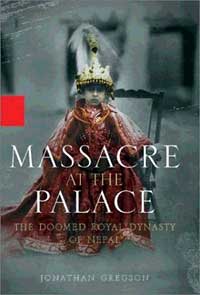 If 11 September, 2001 hadn't destroyed the World Trade Centre and brought down America's wrath on Afghanistan, there would only have been one candidate for news event of the year. That-of course-was the stunning Narayanhiti Palace massacre. Crown Prince Dipendra's crazed rampage shocked and horrified everyone. But other shocks lay in store, even after the death of a beloved king and queen. A political and palace elite had little choice but to put a comatose murderer on the throne of Nepal; the cascade of conspiracy theories and, yes, the unforgettable sight of parliamentary speaker Taranath Ranabath going "rat tat tat tat" with the M16 used to murder King Birendra.
If 11 September, 2001 hadn't destroyed the World Trade Centre and brought down America's wrath on Afghanistan, there would only have been one candidate for news event of the year. That-of course-was the stunning Narayanhiti Palace massacre. Crown Prince Dipendra's crazed rampage shocked and horrified everyone. But other shocks lay in store, even after the death of a beloved king and queen. A political and palace elite had little choice but to put a comatose murderer on the throne of Nepal; the cascade of conspiracy theories and, yes, the unforgettable sight of parliamentary speaker Taranath Ranabath going "rat tat tat tat" with the M16 used to murder King Birendra.
For once, the world was watching Nepal. The skies over Kathmandu were dark with parachutes as journalists leapt in from all over the planet. In a newsroom in North America, a former colleague heard his editor shout "What? I didn't even know they had a king!" Here, camera crews and sought out crying women and angry young men, filming them close-up to depict a nation's mood. The deeply damaging denials by officials, or attempts to play down the events as "sudden occurrences" or "accidents" added to the confusion and anger of Nepalis. For a few short weeks, we all were fearful at the building fury. In the hills, the Maoist leadership was gleeful and clever. In the capital, a seemingly invisible elected government was doing little or nothing to calm people's nerves. It was the most dangerous time in this country's history, and we all knew it instinctively.

So why, I wonder, is this book so anodyne, derivative and downright dull? Jonathan Gregson was quick off the mark; he arrived in Nepal just a few days after the nightmare began on 1 June, 2002. Full marks for that, and for the sterling work of his agent who reportedly landed him a $100,000 advance. Digging out information about the killings in their immediate aftermath wasn't particularly difficult. For once, a royal and Rana elite accustomed to keeping themselves to themselves needed to talk. They poured out their hearts to perfect (and not-so-perfect) strangers from the foreign press. An eyewitness approached me on the street in Kamaladi and within hours had a world exclusive interview, the first but by no means last survivor of the Narayanhiti carnage to go public. Writers like Patrick French mined seamy details of drug deals and alleged political manoeuvring by young royals and the spoiled brats of Kathmandu's rich.
Yet Massacre at the Palace (known inexplicably and awkwardly in Britain as Blood Against the Snows) reads like little more than a mixture of Father Ludwig Stiller on court intrigue in Kathmandu, quotes from the Official Enquiry Report on the killings and eyewitness statements from the BBC documentary, Murder Most Royal. There's no sense that Gregson has spoken to many of the key players and much of the narrative is padded with pointless detail. There are various Hindu myths expanded to take up a page or two. We are treated to several discourses on the interior design of Narayanhiti Palace. Nearly half of the 250-plus pages are given over to an overly dry account of Shah and Rana history.
And there are gaping omissions. Little or no mention is made of the Maoists or the uneasy relations between mainstream Nepali political parties and the Palace. The author-to his credit-is one of the few foreigners to have interviewed the late King Birendra in recent times, yet no new insight is offered into his personality. Even the horrible moments of the massacre don't shock and engage the reader as they should. The recitation of those bloodstained seconds when Tribhuvan Sadan echoed with gunfire is repetitive and poorly edited. And perhaps worst of all, little of the information about Devyani Rana and Dipendra is attributed-even obliquely-to primary sources. This may have been to protect those sources or it could be because
salon gossip and hearsay is being repeated as fact.
The most gruesome and fascinating moment of modern Nepali history deserves better than this. The definitive book on the massacre, its aftermath and the fate of this troubled land has yet to be written.


